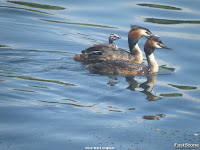Under the willow ... life as young Great Crested Grebe

The Grebe seems to be a very shy bird and hides and cowers away but I have of people saying the parent will attack predators with fury, but it is not something i have witnessed.
The young grebe seems to spend much time in the protection of the parents back, but maybe it is not so surprising they have already lost two chicks, one since Saturday. The survival of chicks was far better last summer.


 Life on the back ... what a life!
Life on the back ... what a life!

 The young Starling also has to call out and follow the parent who catches relevant bits which is then put straight into the open beak of the young bird.
The young Starling also has to call out and follow the parent who catches relevant bits which is then put straight into the open beak of the young bird.While the signets idle about in the water before returning to the bank while the cob with his feathers puffed up goes off in pursuit of any other swans that dare to come to close ..... even across the other side of the lake!!


It may seem to be the ugly duckling in its own eyes but the signet seems to have a confident start although like others they are open to predators particularly in their first week. This pair who have been rearing for a number of years now at Roath seem to work well in partnership keeping a close eye on their Young and their territory!
On occasions the resident black swans, a non native to these waters it has been said attack the young mute signets. I have not seen this but seeing their aggressiveness towards the mute swan in other situations ... see other earlier posting, I can quite believe it!.
Take another Bird that starts life in South Wales
Quite by Contrast the Storm Petrel, which in some ways is not dis-similar to the grebe in that it remains on water other than coming ashore to nest and lay eggs. The storm petrel comes to remote locations off the British and Scandinavian coast for this purpose, including the South Wales coast. The young storm petrel then has to find its own way migrating back to the waters off South Africa for the winter.
A project ran by Cardiff University and A Rosha Portugal has been studying the migration patterns of this small seabird and looking to link changes in weight and diet to see if it correlates to changes in temperature and thus ultimately climate change.
The work is carried out at night on cliffs on the Algarve Coast of Portugal, where the birds are caught in nets, first ringed and then weights and feces samples taken (if the birds cooperate) before being released again.
I volunteered on one of the teams last year. The project is currently on location at the Algarve just now. From all accounts it appears they are getting few birds coming into the nets which must be making the nights sitting anticipating the birds coming in long and tedious.
You can watch the projects progress by going to: http://stormies-online.blogspot.com/

This was a water colour painting I created as I anticipated working on the project with the stormies coming into the nets as a result of playing recordings of their bird song.


Another great blog post clive.
ReplyDeletei like the picture of the baby Grebe on the back of the mother Grebe. Great!